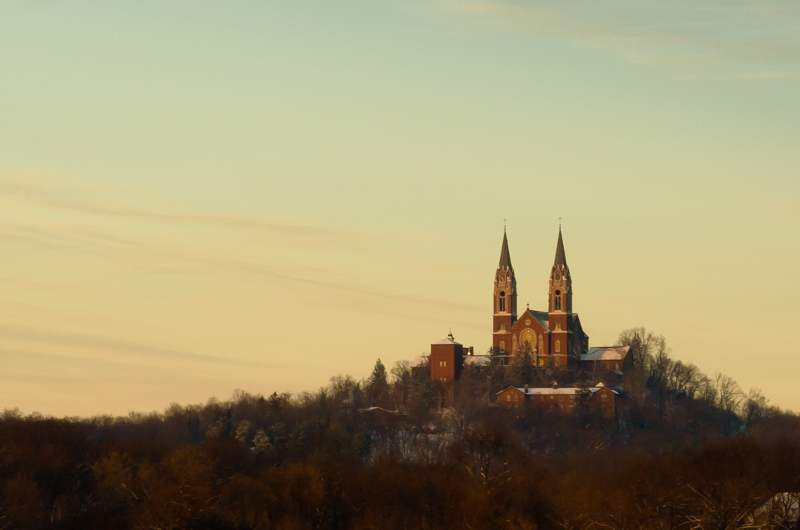Grade Levels
CollegeDuration
One class period (75 minutes)Associated Entries
Holy HillAuthor
Krista Grensavitch
Standards
| Reflect critically on cultural identity and background, connecting personal history to larger social and historical forces. | |
| Critically analyze the historical and social construction of categories such as “race” and “ethnicity,” and their impact on various dimensions of human life, including how such constructions create systematic inequalities between the dominant and the marginalized. | |
| Collaborate productively and communicate constructively with people from diverse backgrounds. |
Introductory Activities
Students should read the Encyclopedia of Milwaukee entry on “Holy Hill” (approx. 250 words). This could be read on a projection, printed sheet, screen, or read aloud (5 minutes).
The instructor/facilitator then asks the following question to be completed as a think-pair-share activity in groups of 2-3 (5 minutes):
- Based on your reading of the entry, who visits Holy Hill and why might they visit?
The instructor/facilitator asks a follow-up question, to be completed as a think-pair-share activity (in same groups of 2-3). Following the small group discussion, students should share out general responses and impressions with the larger group (10 minutes):
- Based on the identities/affiliations of people you identified in the last prompt, what factors might permit or prohibit people’s access to a place like Holy Hill?
Developmental Exercises
Using the same small groups, the instructor/facilitator instructs students to search for “Holy Hill” using the “Search Site” function on the EMKE website. Students should then filter their results by selecting the “Images and Maps” category to access the images of Holy Hill. As they search, ask students to note and discuss their impression of how Holy Hill is represented in the images, paying special attention to vantage point and scale. (10 minutes)
Ask students to share their responses with the larger group. The instructor/facilitator should note students’ responses on a white/blackboard or some other visual medium for all to see (5 minutes).
Play the video “Experiment in Education: Holy Hill” (follow link). Ask students to note their impression of how Holy Hill is represented in the video, again paying special attention to vantage point and scale. In the same small groups students used for the earlier think-pair-share, ask students to discuss their responses and then share out with the larger group. Again, the instructor/facilitator should note students’ response on a white/blackboard or other visual medium for all to see (15 minutes).
Closure
To begin wrapping up the lesson, ask students to consider the different representations of Holy Hill they just investigated: the EMKE-hosted images and the brief video and pose some/all of the following prompts to the whole class; if possible, project the prompts so that they remain visible to students throughout the discussion. Encourage discussion and allow students to respond to one another. (Teaching and learning tip: remain flexible to student insights, developing further prompts that respond to student reflections [as class time permits]):
- How do the representations of the space help you to imagine why people might visit a space like Holy Hill?
- What terms can we use to classify Holy Hill as a space: is it public/private/religious/secular? Something else?
- Based on the way we classify space, how does that permit/prohibit access to that space?
- How does this classification permit/prohibit on the basis of individual identities?
- Does the use of space change over time? If so, how?
- Based on the resources we explored today, do you observe any changes in the way that Holy Hill is used? If so, describe how that change happens, and under what circumstances?
- If applicable, how does your personal experience or knowledge of Holy Hill come to bear on the way you respond to our discussion today?
In a culminating prompt (again, if possible, project so that it remains visible), ask students to consider the following, and again complete as a think-pair-share activity (final 5 minutes):
- Think back on the ways and through what methods we have encountered Holy Hill as a space that can be encountered and/or visited. How did your understanding of who might visit Holy Hill and how their access may be permitted or prohibited change over the course of the class discussion?
Extension Activities
Students could be instructed to conduct a similar investigation of physical space/s (included in EMKE) and create a video like the one included in this Experiment in Education.
For more information on creating videos like the one in this assignment, visit Spirit of Space’s website: https://www.spiritofspace.com/ and Vimeo page: https://vimeo.com/spiritofspace. Spirit of Space films, edits, designs, and produces short videos and believes that “buildings tell stories.” Their work maintains that design and architecture should remain accessible and that experiencing architectural and designed spaces (through their videos) should work to create empathy. Using the video and information from Spirit of Space as a framework, an instructor (or students) could create similar videos using a smart phone and simple video editing software.